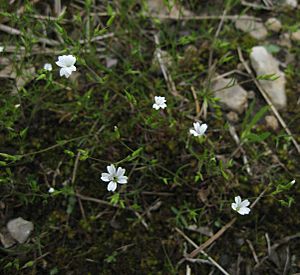Minuartia patula facts for kids
Quick facts for kids Minuartia patula |
|
|---|---|
 |
|
 |
|
| 1913 illustration | |
| Scientific classification | |
| Genus: |
Minuartia
|
| Species: |
patula
|
| Synonyms | |
|
|
Minuartia patula, also known as pitcher's stitchwort or lime-barren sandwort, is a small plant. It lives for only one year, which means it's an annual plant. This plant belongs to the Caryophyllaceae family, which includes many types of flowers.
About Pitcher's Stitchwort
Minuartia patula is found in parts of the eastern and central United States. You can mostly see it in the lower Mississippi Valley. It also grows in the southern Great Plains and the Tennessee Valley. Sometimes, you can find small groups of these plants in Georgia, Virginia, Pennsylvania, and near the southern Great Lakes region.
Where Does it Grow?
This plant likes to grow in special places. It is often found on limestone rocks. It also grows in rocky areas called "barrens" or "glades." These are open, rocky places where other plants might not grow well.
What Does it Look Like?
Minuartia patula is a very small and delicate plant. It has thin stems that are often red. These stems can grow up to 30 centimetres (1 ft) long. They can stand straight up or trail along the ground before curving upwards. Often, many stems grow together. They cross each other to form a small clump.
The leaves of this plant grow in pairs. They are narrow and usually less than 20 millimetres (0.8 in) long. In the spring, Minuartia patula produces small white flowers. These flowers bloom quickly and then wilt soon after.
Different Varieties
Minuartia patula can look a bit different depending on where it grows. Because of these differences, people have given different names to various types of the plant. However, these different names are not widely used today. Scientists usually just call it Minuartia patula.

